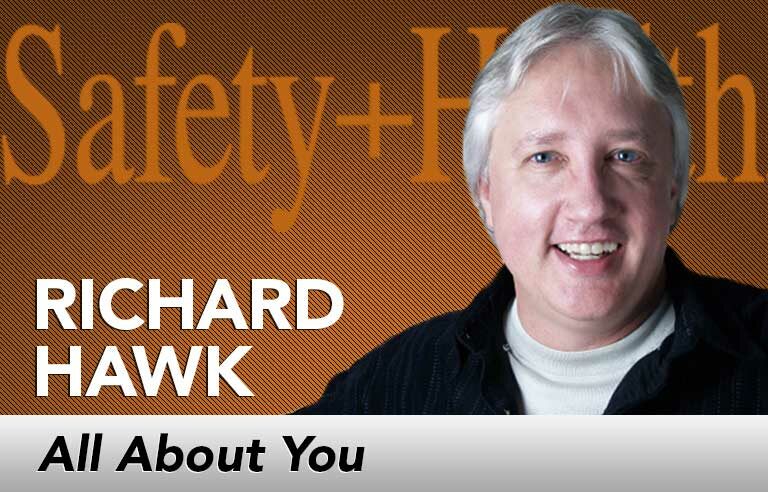All About You: The power of praise

EDITOR’S NOTE: Motivating employees to work safely is part of the safety professional’s job. But who motivates the motivator? In this monthly column, veteran safety pro and professional speaker Richard Hawk offers his entertaining brand of wisdom to inspire safety pros to perform at their best.
Praise is powerful. And we all enjoy receiving it when it’s honest and not prompted by ulterior motives. Telling people how much you appreciate their work or something they’ve done benefits you as well because it creates pleasant feelings.
Besides making people feel good, praise can inspire employees to perform better. This makes the ability to praise a valuable leadership tool.
Safety professionals often have to point out problems and risky conduct – it’s part of our responsibilities. However, it sometimes makes employees feel like the little boy who said (after his mom hollered at him for tracking in dirt), “How come you never say anything about the dirt I take with me when I go outside?” That’s another reason it’s important to be skilled at giving praise: to offset the corrections we have to give.
How skilled are you at giving praise?
The most influential safety professionals are the ones who focus on positive behaviors and are adept at giving praise. How about you? How are your skills at giving honest, ?behavior-improving praise? No matter how strong a “praiser” you are, examining those skills can improve your ability to inspire. Here are some questions to help you do that:
- Do I feel comfortable giving praise?
- Do my co-workers consider me a person who looks for the positive in other people’s actions, or do they think I’m quick to notice faults?
- How often do I give praise? Is it enough?
- How many times during the past two days have I complimented someone? Did I sound sincere? How did the other person react? (How people react to your praise is a solid indication of how well you give it. If they feel uncomfortable or dismiss it, you might need to change your tactics. If they smile, perk up and seem happier, it’s a strong indication your praise is well-accepted.)
- Do I always say the same thing when I congratulate someone, or do I vary what I say based on the person and situation? (Always saying “nice job” makes the praise eventually lose its impact.)
- What do my colleagues and other employees say about my ability to inspire?
Each person’s praising style varies. Still, there are some common best practices. Here are a few:
Rehearse a bit: You don’t have to memorize what you’re going to say. It isn’t a formal speech. But a thought-out accolade is more likely to flow smoothly than one you say off the cuff.
Reward now, not later: After you’ve thought it over, acknowledge a good job as soon as possible. The longer you wait, the less impact the pat on the back will have. You can still honor the person at a special meeting, but unless you want it to be a surprise, give out praise as soon as possible.
Maintain eye contact: Looking employees in the eye is critical because people perceive a lack of eye contact as a sign of insincerity or lying. However, know that some employees may look away from you if they feel uncomfortable accepting honest, straightforward commendations.
Sound sincere: The most heartfelt praise will miss its mark if your tone of voice doesn’t convey genuine enthusiasm. Your level of excitement, as well as your words, tells people how you feel. Saying “I was impressed with the way you set up that job yesterday” actually may come across as an insult if your voice is monotone. Don’t go overboard – it may make you sound fake – but put some positive emotion in your voice.
Dale Carnegie once wrote, “The rare individual who honestly satisfies this heart-hunger [praise] will hold people in the palm of his hand, and even the undertaker will be sorry when he dies.”
Besides giving you influence, catching people doing things right and praising them for it will help your employees create a sense of pride in their safe work practices, which in turn makes them more apt to follow safety procedures and policies. Now that’s powerful!
Richard Hawk helps companies around the world create more vibrant safety cultures by showing them how to make safety fun. As a professional speaker, author and musician, he also inspires employees to focus better and enlightens safety leaders about ways to increase their influence. To learn more about Richard, visit www.makesafetyfun.com.
Subscribe to the podcast feed in iTunes
Post a comment to this article
Safety+Health welcomes comments that promote respectful dialogue. Please stay on topic. Comments that contain personal attacks, profanity or abusive language – or those aggressively promoting products or services – will be removed. We reserve the right to determine which comments violate our comment policy. (Anonymous comments are welcome; merely skip the “name” field in the comment box. An email address is required but will not be included with your comment.)

